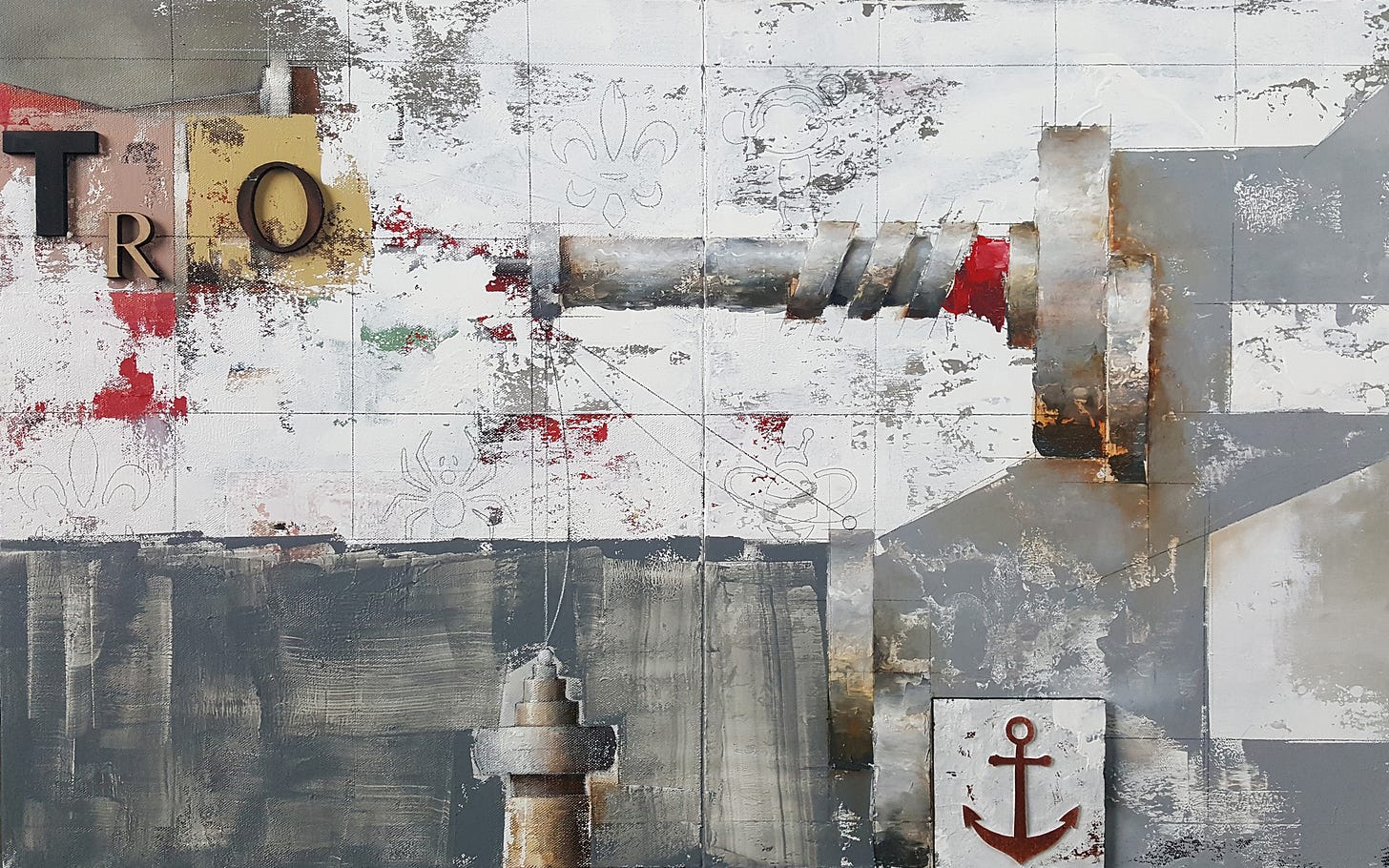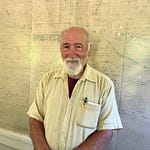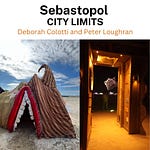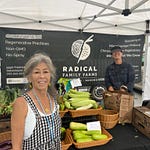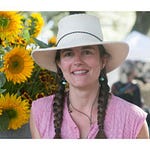Sebastopol artist Ken Berman’s painting, “Temporary Restraining Order,” was selected for a new juried Open ‘23 show at SF's de Young Museum, which is open now and runs through the January 7th. Berman is a bit of an outlier among Sonoma County artists; he doesn’t do landscapes or seascapes. Instead, as a young man growing up in Pennsvylvania and New Jersey, Berman was inspired by steel mills and railroads as well as Rube Goldberg and Salvador Dali to look at the surface of the world around us and see inside it to find something in the complexity of its details. He calls his art “industrial whimsy.”
In this conversation, Ken and I talk about his background as an architect and an artist. He sees himself as an outsider, a self-taught artist who learned what he wanted to do by doing it, painting day after day. He says: “I feel like my role is to paint and my goal is to show the work, and then (I have) the faith that there will be people there (to see it.)” Having his painting selected for the show at the de Young Museum provides Berman with “higher level validation” for the work he does.
Links
Transcript
Dale: I'm with Ken Berman. Ken, just as an opener, if you had a neighbor come up to you, one you don't know, and he said tell me about yourself. How would you introduce yourself?
Ken: I'd have to probably start off with being a student in architecture, because most people can relate to that. Either they went to school and they drafted things or, so that's where it really all began when at 18 I went to Lehigh University, which was across the river from Bethlehem Steel.
So a lot of the iconography, a lot of the industrial, that's where it originated. I actually had an apartment on the railroad tracks. So I heard the coal cars coming in to feed the furnaces, the blast furnaces. And this is when Bethlehem Steel was still operational.
What it became, almost had a life force that I was responding to, or I am still responding to.
Dale: That's interesting. Would you tell them you're an artist?
Ken: That's how I would segue into, yes, I'm an artist. So that they understood where the foundation came from. The prelude to it was that it wasn't just, I came to, geez, I just had this in my head.
I was going to paint industrial whimsy is what I've been calling it lately. It actually, it originated in architecture. It originated in steel mills and it's just evolved as as I've gotten older.
Dale: You're included in an exhibition at de Young Museum. Tell us about that.
Ken: Basically it's I guess they call it triennial. So every three years they've been trying to do and open up this competition to artists within the nine Bay Area counties. This year, yeah, I was lucky enough to put in my entry and it was accepted.
So they had the opening for the artists a couple days ago and the official opening will be tomorrow.
Dale: That's Saturday September 30th? And how long will that run?
Ken: Until the first week of January in 2024. So it's a really good, it's a long -- you can come to the museum, I think is free on Saturdays.
Dale: So what does that mean to you as an artist to be accepted into kind of an institution like that?
Ken: You need, I think every artist, you need some level of validation. Yes, we can all paint in our studios, but there's always that desire that I got to show it to somebody, it doesn't matter by your parents, friends, maybe some people do Art Trails or Art at the Source and they open up their studios, but once, once you graduate for certain things, then you go I need more than that. I need some validation at a higher level. And so this was great. It gave us for 7, 000 plus artists, an opportunity to get something validated that maybe they've been working on for a couple of years.
Or like me, this has been a 20 plus year excursion into the world of industrial whimsy,
Dale: Talk about the origins. You describe yourself as self taught. You didn't go to art school. You went to architecture school, but you didn't go to art school. So this was something you developed somewhat on the side and has become a pretty important part of your life, right?
Ken: I actually had a really interesting thing happen when I was in graduate school. I went to NJIT. I went to Lehigh for my undergraduate and I went to NJIT, which is a New Jersey Institute of Technology.
And I was invited to go to a book signing for an artist. His name was Robert Rauschenberg. And Robert Rauschenberg is Jasper Johns, Warhol-- he's at that level. I didn't know who he was. I went to architecture school. And so I didn't really know who these artists were, but I met him and I talked to him.
How do you know you're an artist? And he said you're an artist if you wake up every morning and you want to make, you want to create whatever your art is. And I thought, Oh geez, that's all it is. That's pretty easy. That set the bar pretty low. I really enjoy painting and creating things. So I guess I'm an artist.
So that was the prelude into being included into, I guess, the artist category.
Dale: It's a interesting label where some people aren't sure whether they fit being an artist, right? Or whether it applies to them or when in their life it might apply to them or how much they have to do that.
He gave you inspiration to just... start thinking of yourself as an artist, right?
Ken: I think so, because if he was that willing to basically just, that's how I describe it. It's just that doesn't really set the bar that hard. I don't need to go get an advanced degree. I don't need a bachelor's degree in it. I could just start right now and start playing around with paints and I had that artistic license to do it. For any artist, it's a program that you never graduate from, right? You're never out of school.
Dale: That's actually a good thing. How did you Find what you wanted to paint. Subject matter. You mentioned the Bethlehem Steel thing that being formative for you, but did you start with that right away, trying to work in that direction?
Ken: Not really. I started, I was much more of a colorist. I played with a lot of color. I really liked that. Then I was really into Surrealism when I first started. So Dolly and I still am. I think there's a, that's where the whimsy comes in. That's where a little bit of more of the idiosyncratic kind of things come in.
It can't just be me replicating machines because that's not really what I'm trying to do. Take a picture of that. To me, there's these intangibles and there's connections that get made or reconnections get made. Something happens and there's a cause and effect.
And so sometimes when I start a painting, I might start off and I think it's going to be something else and it just transforms and becomes its own thing. I've just learned to let that storyline guide me.
Dale: Your work would be hard to describe just in words, don't you think?
Ken: That's why people, they try to group you. Okay, you're the machine guy or you're this. And I think the descriptions really limit what the reality of the visual, what the paintings could be. Because each person-- that when I've done more shows, some people love it, some people don't really like it.
But there isn't anybody that just goes what did I, what was I looking at here? I don't quite, you got to tell me the story. You got to explain at least a little bit because, how'd you get there? Or, each individual painting, what the symbolism might be.
Dale: I saw something you wrote, you're really interested in the complexity of the world around us, which includes all this technology and machines and things even more so today.
When we think of fine art, it kind of filters that out. We want something, what we think is beautiful and it might be a landscape, it might be a portrait or things, but this technological machine is all around us.
Ken: Think about what we're using right now.
For us, it's just a medium like any other medium. We could be painting a painting, it would just take us forever to communicate. But to me it's a medium. It's a way of me addressing, like you said, the complexities of the world. Sometimes I'll come up with a painting title, like the one that got into the show is Temporary Restraining Order, right?
Dale: That's a great title. Terrible in a way, but.
Ken: Exactly.
Dale: It's a great title.
Ken: You think about what the pretense like what happened, what, why, was it really bad or, weird. And in a lot of ways it was just watching the TV show Suits, which is on TV right now and just how the attorneys kept manipulating situations and that's what I do with the machine.
It's not, it's just a series of complexities and a series of decisions that you make. And then within that one painting, it's about holding it up. It's temporary restraint. Just, we got to hold that moment in a lot of ways.
Dale: Do you teach art?
Ken: I've been asked to give classes and the one class I did do, it was funny. I bored most of the people in the first 15 minutes. So they all left. But the funny part of it is that the 10 people that were left, I started to give them demonstrations. The people that had left early would come back when I did Art Trails, and they said, we missed it. We left too early. You got to show us what you showed everybody else. And I almost felt yeah, you should have stayed a little longer. . But I have taught a little bit.
Dale: Yeah. It's interesting. I think people do want to know how sometimes, just to watch people work and do the thing itself.
Ken: When I first started mixing paint, that's what most artists you're going to-- you have a little dab, a little tube of paint, especially oil paint, which is what I use. And you put a little dab on a palette and then you paint from there. I basically take a whole wad of paint and goop it onto a palette and then I move it around with like basically cake-making or cake-baking tools.
So I move a lot of paint. And when I first did that for the class, people were, they were gasped. They were like, Oh my God, you're wasting all that paint. And I'm like no. Watch what I do. And in the end, you'll see, it's just my God, you use it. Where'd all that paint go? You made this big, huge blob of paint on the palette and then, but somehow it got mastitized onto the canvas.
And it all started to work.
Dale: How did you get to Sebastopol? What brought you here?
Ken: The route was New Jersey to San Francisco to San Rafael, to Petaluma to Sebastopol. At each point I actually got a little bit bigger studio space along the way to paint.
In New Jersey it was just my bedroom. San Francisco was a whole closet that was big enough, almost big enough to be a bedroom in San Francisco. , San Rafael was part of a garage. Petaluma was my dining room, and then when I got to Sebastopol, I had enough room in my architectural office to have a little studio, and then now I actually built a studio,
Dale: Are you part of a community of artists in the North Bay? Do you connect to local artists here, or do you just work on your own?
Ken: That's a great, that really is a great question. I've really tried to be part of the art scene here, but to be honest with you, most people don't want me.
It's landscapes, and it's certain things that certain groups, and the birds of a feather, and they're, that's where they-- I'm an outsider, and so as much as I try to get in, I have long ago just assumed like, Hey, look, this is just my thing. I just got to keep doing it.
If there's a group of people that want to take me in great. If not, I'll just keep going.
Dale: Outsider is an interesting term. That's an important part of who you are, maybe?
Ken: I think so. I think so. In every art, some artists, I think they, they can paint things that are outside what is normal, what is considered normal, right? A portrait or a landscape. And there's some that will dabble in abstract art.
And there's some that are pushing a little bit further than that. Maybe, whatever their medium is. To me, the further I can get away from that meant that I was much more confident that I could see myself or see my art in it, in the way that it wanted to be seen. Regardless of it, it didn't need any validation.
It didn't need anybody to say, that's great or pat me on the back. It was going to be just like, we're going to explore this and see how far we get with it.
Dale: So let's talk a little bit about your life as an architect. Do you still practice?
Ken: Yes. I have to do that, pay the bills.
Dale: What kind of work do you do there?
Ken: Mostly residential. It's anything like decks to additions, bathroom remodels, but we do new houses too. When the fires happened, we did quite a few of the fire rebuilds.
Dale: Does that feel different or similar to what you do as an artist?
Ken: There's a lot of discipline in having to do architecture. From coordinating plans with owners to construction, the whole thing. That actually does come in handy when it comes to art. Because if you don't have that discipline in setting up shows, and making sure your pricing is together, it would be hard to just be an artist that just comes to it whenever.
You'd be really hard pressed. You'd fall into that, oh, you're an artist category, right? You're like, oh, no one expects much. But when you're as disciplined or forced to be as disciplined in doing architecture, it's easy to segue and move that into another discipline. That really is, it would be a benefit to having those skill sets.
Dale: You did an exhibit, which was maybe your art and architect hats on at the same time, the portable shelters that would be towed by a bicycle. That project was a few years ago, but talk a bit about that.
Ken: In Healdsburg, there was a there were a group of homeless, people that a friend of mine who another artist up in Healdsburg asked me, Hey, look, I got this idea and you're an architect and you can design these things.
So we went up and we met with a bunch of the homeless people that in Healdsburg. And so that's how it started. It was really fascinating because I did a show it at Paul Modder gallery as one of the unveilings of it. They invited homeless people, they invited the typical gallery collectors there, and everyone commingled, right?
No one really could tell who was necessarily homeless or who wasn't. And, it was just something that being asked to do it, and then having the architecture background, and then built it myself. I actually built the prototype myself. And it worked. I thought it'd be like, this could be really cool.
Unfortunately, within the county and the state, they really want to provide homes. They don't want to have these shelters all over the place. They want the homeless in, full time housing, heated spaces. It's an idea that really probably can only go as far as a prototype, I think.
Maybe camping? I don't know. Maybe you might see that as portable camping.
Dale: It's somewhere between a tent and a tiny house, right?
Ken: It's a little bit hard to make it. I envision it out of... It might be like tent material. It could be something that was lightweight and portable.
Maybe you could fold it up and it could be like a multi purpose, it could be something you sleep in. It could be something you drag.
Dale: When I think of an architect, I think of that they work on projects, someone comes and actually design a house and you do that. Do you think about your art that way? Or is it just every day I just get up and paint? Or do you think like there's a thing I want to do out there and I'm building towards that? Or it's not just a painting, but some new idea that I'm working on.
Ken: I think I do. I think in the big picture, there is a big, I don't know what it looks like, but there is this big edifice of some kind that has a bunch of my paintings that create this, whatever it is, it could be a building.
I don't know what it is I'm exactly building. It's Noah's Ark. I gotta build this big thing. I guess there's going to be a whole bunch of animals that get brought into it for some purpose. I don't know. But there is a bigger picture, I think, but I don't know what that is.
One of the things I do feel like I do I have faith in it, in and of itself. I feel like my role is to paint, and my goal is to show the work, and then the faith is that there will be people there or it's if you build it, they will come.
Dale: How do you function as an outsider? I'm saying that more of the personality than describing your art, but in these sort of art worlds that are very stratified, they go on those clues of what status means, how does that feel? You're taking something that's very personal to you and putting it into an environment where you could almost say they don't always care very much about that the work itself.
Ken: Part of my story I guess or the autobiography would be the underdog I think if there was any, if there .Was a current that really gave it the outsider, that edge, it would be the underdog, is that when you look at gallery or museum edifices, you envision it being populated by people of prestige and and a certain level of social, almost like a class stratus, right?
For me, I enjoy being the underdog or I enjoy being the outsider because then I'm not encumbered by having those things. I can bring the work in if it's good work and it can be compared with other people who are also doing their best work and then you could look at them side by side and really evaluate it and then everything gets measured appropriately.
And then you feel like-- take out the social strata and then look at it just for what was created and then gauge that or grade that based on what that artist had achieved.
So basically, the idea of having your artwork in a democratic situation, a lot of what the de Young is trying to do in a blind jurying process is to democratize who is actually getting into these shows.
As an outsider artist or an underdog, I see myself as that's a great opportunity to be validated or weighed and measured against other people who are pursuing their own art in maybe the same way and all heading towards whatever goal that personal goal that they're trying to achieve.
Dale: That's a good place to end. Why don't you just summarize the de Young dates again?
Ken: The show runs to January 7th, I believe. It's the nine Bay Area counties surrounding basically San Francisco, so I'm really proud and humbled by being able to have a chance to I don't know, represent Sonoma County, but my little part of it. The industrial whimsy part of it.
Dale: Congratulations to you Ken. And it's been a pleasure talking to you.
Ken: You too, Dale.



